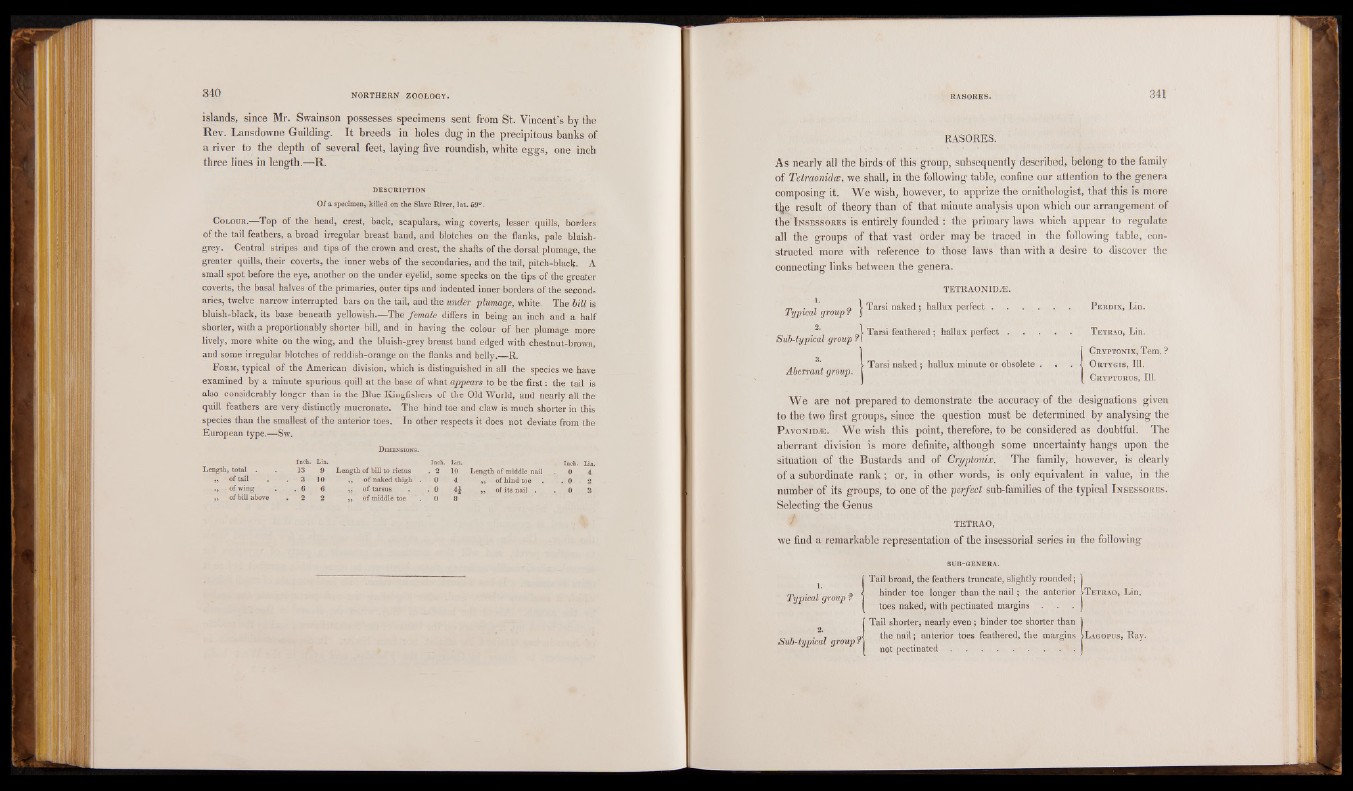
islands, since Mr. Swainson possesses specimens sent from St. Vincent’s by the
Rev. Lansdowne Guilding. It breeds in holes dug in the precipitous banks of
a river to the depth of several feet, laying five roundish, white eggs, one inch
three lines in length.—R.
DESCRIPTION
Of a specimen, killed on the Slave River, lat. 69°.
Colour.—Top of the head, crest, back, scapulars, wing coverts, lesser quills, borders
of the tail feathers, a broad irregular breast band, and blotches on the flanks, pale bluish-
grey. Central stripes and tips of the crown and crest, the shafts of the dorsal plumage, the
greater quills, their coverts, the inner webs of the secondaries, and the tail, pitch-black. A
small spot before the eye, another on the under eyelid, some specks on the tips of the greater
coverts, the basal halves of the primaries, outer tips and indented inner borders of the secondaries,
twelve narrow interrupted bars on the tail, and the under plumage, white. The bill is
bluish-black, its base-beneath yellowish.—The female differs in being an inch and a half
shorter, with a proportionably shorter bill, and in having the colour of her plumage more
lively, more white on the wing, and the bluish-grey breast band edged with chestnut-brown,
and some irregular blotches of reddish-orange on the flanks and belly.—R.
Form, typical of the American division, which is distinguished in all the species we have
examined by a minute spurious quill at the base of what appears to be the first: the tail is
also considerably longer than in the Blue Kingfishers of the Old World, and nearly all the
quill feathers are very distinctly mucronate. The hind toe and claw is much shorter in this
species than the smallest of the anterior toes. In other respects it does not deviate from the
European type.—Sw.
Dimensions.
Length, total . Inch. Lin. Inch. Lin. Inch. Lin 13 9 Length of bill to rictus . ,, of tail . 2 10 Length of middle nail 0 4 - of wing . 3 10 •• „ -of naked thigh . 0 4 ,i of hind toe . 0 2 . 6 6 „ of tarsus . . 0 . ,,. Of its nail . • o 3 „ of bill above . 2 2 „ of middle toe 0 8
RASORES.
As nearly all the birds of this group, subsequently described, belong to the family
of Tetraonidce, we shall, in the following table, confine our attention to the genera
composing it. We wish, however, to apprize the ornithologist, that this is more
the result of theory than of that minute analysis upon which our arrangement of
the I nsessores is entirely founded : the primary laws which appear to regulate
all the groups of that vast order may be traced in the following table, constructed
more with reference to those laws than with a desire to discover the
connecting links between the genera.
Typical group? j
Sub-typical group?
Aberrant group.
TETRAONIDCE.
> Tarsi naked; hallux perfect . .
Tarsi feathered; hallux perfect .
Tarsi naked ; hallux minute or obsolete .
Perdix, Lin.
Tetrao, Lin.
Çryptonix, Tem. ?
Ortygis, III.
Crypturus, 111.
We are not prepared to demonstrate the accuracy of the designations given
to the two first groups, since the question must be determined by analysing the
P avonid^e. We wish this point, therefore, to be considered as doubtful. The
aberrant division is more definite, although some uncertainty hangs upon the
situation of the Bustards and of Cryptonix. The family, however, is clearly
of a subordinate rank; or, in other words, is only equivalent in value, in the
number of its groups, to one of the perfect sub-families of the typical I nsessores.
Selecting the Genus
TETRAO,
we find a remarkable representation of the insessorial series in the following
sub-genera.
Typical group ?
2. Sub-typical groupé
Tail broad, the feathers truncate, slightly rounded;
hinder toe longer than the nail; the anterior
toes naked, with pectinated margins
Tail shorter, nearly even; hinder toe shorter than
the nail; anterior toes feathered, the margins
not pectinated ...................................... ...... ' .
T etrao, Lin.
-Lagopus, Ray.